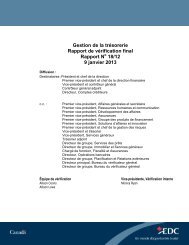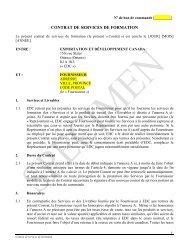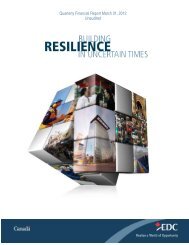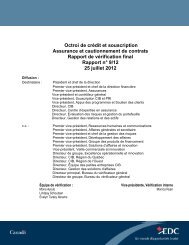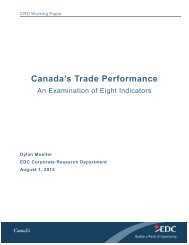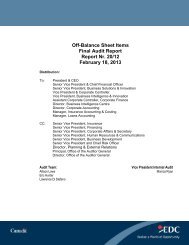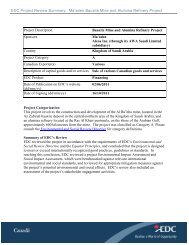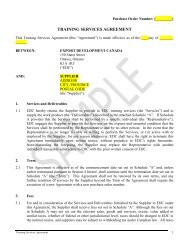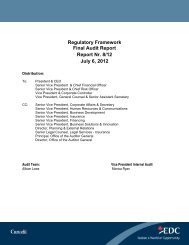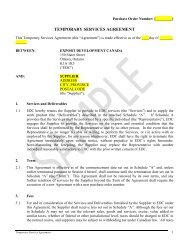Accounting for Financial Instruments - Final Audit Report ... - EDC
Accounting for Financial Instruments - Final Audit Report ... - EDC
Accounting for Financial Instruments - Final Audit Report ... - EDC
Create successful ePaper yourself
Turn your PDF publications into a flip-book with our unique Google optimized e-Paper software.
Distribution:<strong>Accounting</strong> <strong>for</strong> <strong>Financial</strong> <strong>Instruments</strong><strong>Final</strong> <strong>Audit</strong> <strong>Report</strong><strong>Report</strong> 23/12March 6, 2013To:President & CEOSenior Vice President & Chief <strong>Financial</strong> OfficerSenior Vice President & Chief Risk OfficerVice President & Corporate ControllerVice President, Risk ManagementDirector Corporate <strong>Accounting</strong>Director, Market Risk ManagementManager, Loans <strong>Accounting</strong>CC:Senior Vice President, Corporate Affairs & SecretarySenior Vice President, Human Resources & CommunicationsSenior Vice President, Business DevelopmentSenior Vice President, InsuranceSenior Vice President, FinancingSenior Vice President, Business Solutions & InnovationDirector, Planning & External RelationsPrincipal, Office of the <strong>Audit</strong>or GeneralDirector, Office of the <strong>Audit</strong>or General<strong>Audit</strong> Team:Eric HunterJennifer KrysAllison LoweVice President Internal <strong>Audit</strong>Monica Ryan
Table of ContentsIntroduction ........................................................................................................... 3<strong>Audit</strong> Objectives & Scope ..................................................................................... 3Internal <strong>Audit</strong> Opinion ........................................................................................... 3<strong>Audit</strong> Findings & Recommendations ................................................................... 4Conclusion ............................................................................................................ 5<strong>Accounting</strong> <strong>for</strong> <strong>Financial</strong> <strong>Instruments</strong> 2
Introduction<strong>Financial</strong> instruments (FIs) are broadly defined as any contract that gives rise to a financial asset of oneentity and a financial liability or equity instrument of another entity. <strong>EDC</strong>’s balance sheet includessignificant (FIs) such as loan assets, marketable securities, debt, and derivatives. Accordingly, weper<strong>for</strong>med an audit of the process to establish and report the values of significant FIs included in <strong>EDC</strong>’sfinancial statements. This involved reviewing the process <strong>for</strong> establishing and reporting fair value. FVrepresents an estimation of the amount <strong>for</strong> which an asset could be exchanged, or liability settled betweenknowledgeable, willing parties.<strong>Audit</strong> Objectives & ScopeThe overall objective of this audit was to evaluate the design and operating effectiveness of the controls inplace to ensure that:Valuation techniques are correctly applied to each type of financial instrument;Models used in the determination of fair values are independently reviewed and subject to a<strong>for</strong>mal change management process;Data inputs into models are both accurate and complete; and,Presentation and disclosure of FIs in <strong>EDC</strong>’s financial statements is in compliance with IFRS.<strong>Audit</strong> fieldwork was per<strong>for</strong>med from November 2012 to January 2013.Internal <strong>Audit</strong> OpinionIn our opinion the process surrounding the recording, valuation and presentation of <strong>Financial</strong> <strong>Instruments</strong>in <strong>EDC</strong>’s financial statements is Well Controlled 1 . Controls are designed and operating effectively toensure valuations are reasonable and reporting is in compliance with relevant International <strong>Financial</strong><strong>Report</strong>ing Standards (IFRS). Moderate 2 issues were noted and are described in the following section.1Our standard audit opinions are as follows:- Strong Controls: Key controls are effectively designed and operating as intended. Best in class internal controls exist. Objectivesof the audited process are most likely to be achieved.- Well Controlled: Key controls are effectively designed and operating as intended. Objectives of the audited process are likely tobe achieved.- Opportunities Exist to Improve Controls: One or more key controls do not exist, are not designed properly or are not operatingas intended. Objectives of the process may not be achieved. The financial and/or reputation impact to the audited process ismore than inconsequential. Timely action is required.- Not Controlled: Multiple key controls do not exist, are not designed properly or are not operating as intended. Objectives of theprocess are unlikely to be achieved. The financial and/or reputation impact to the audited process is material. Action must followimmediately.2The ratings of our audit findings are as follows:− Major: a key control does not exist, is poorly designed or is not operating as intended and the financial and/or reputation risk ismore than inconsequential. The process objective to which the control relates is unlikely to be achieved. Corrective action isneeded to ensure controls are cost effective and/or process objectives are achieved.− Moderate: a key control does not exist, is poorly designed or is not operating as intended and the financial and/or reputationrisk to the process is more than inconsequential. However, a compensating control exists. Corrective action is needed to avoidsole reliance on compensating controls and/or ensure controls are cost effective.− Minor: a weakness in the design and/or operation of a non-key process control. Ability to achieve process objectives is unlikelyto be impacted. Corrective action is suggested to ensure controls are cost effective.<strong>Accounting</strong> <strong>for</strong> <strong>Financial</strong> <strong>Instruments</strong> 3
<strong>Audit</strong> Findings & Recommendations1. Calculation of the Fair Value of Loans ReceivableConsistent with IFRS, <strong>EDC</strong> reports its Loans Receivables at book value and discloses fair values in theaccompanying notes to the financial statements. The calculation of the fair value of <strong>EDC</strong>’s LoansReceivable is per<strong>for</strong>med in an Excel spreadsheet with an imbedded model which applies yield curve ratesin order to calculate the net present value (NPV) of the future cash flows associated with each loan. Wefound that the loan book dataset used to calculate NPV did not specifically identify revolvers. As a result,the NPV calculation <strong>for</strong> revolvers was understated as it did not include all cash flows from interestpayments. Loans accounting took immediate action during the audit to address the issue and ensure thatthe fair value of revolvers was correctly calculated at year end. We also found that the maintenance andoperation of the spreadsheet used to calculate the fair value relies on the knowledge of a single resource.Change management controls such as user testing of changes to the model have not been established.We have recommended that documentation related to the loan book dataset, in particular thedocumentation of the methodology <strong>for</strong> the treatment of revolvers be enhanced. We have alsorecommended that spreadsheet controls be strengthened. This includes identification of a back-upresource and establishment of a change management process. In addition, a process should be establishedto collectively ensure that the fair value calculations are correct.Rating of <strong>Audit</strong> Finding - ModerateAction Owner – Manager, Loans <strong>Accounting</strong> and Director, MRMDue Dates - All actions to be implemented by Q3 20132. Fair Value of Derivatives – Credit Valuation Adjustment (CVA) CalculationCVA is a measure that adjusts the fair value of a derivative to incorporate counterparty credit risk. On amonthly basis, a CVA adjustment is applied to the computation of the fair value of derivatives. <strong>EDC</strong>calculates CVA using an Excel spreadsheet which requires significant manual entry and manipulation. Aprocedures manual and general model description exist. However, the spreadsheet is complex and themacros and <strong>for</strong>mulas are not well documented. Given the complexity and impact of the CVAspreadsheet, we have recommended that the documentation be enhanced to include an explanation of themodel design and <strong>for</strong>mulas to ensure it is well understood and able to be validated. In addition, a changemanagement process should be established such that any changes to <strong>for</strong>mulas, cells or assumptions andtheir associated rationale are validated.Rating of <strong>Audit</strong> Finding - ModerateAction Owner – Director, Corporate <strong>Accounting</strong> in collaboration with Director, MRMDue Dates - All actions to be implemented by Q3 2013<strong>Accounting</strong> <strong>for</strong> <strong>Financial</strong> <strong>Instruments</strong> 4
3. Collateral PositionsAs outlined in the Risk and Capital Management Policy, collateral agreements are used by <strong>EDC</strong> tomanage excess concentrations of counterparty credit risk. Under the terms of the agreements, whenexposure with a counterparty surpasses an agreed upon threshold, collateral must be posted by thecounterparty with an independent third party. It is the responsibility of MRM to calculate counterpartycredit risk positions and make collateral calls when predefined limits are exceeded. Treasury <strong>Accounting</strong>uses collateral positions in determining the CVA value to calculate the fair value of derivatives. Wefound that monitoring of counterparty positions against limits is per<strong>for</strong>med by one employee and is notsubject to review/approval. In addition, we found that <strong>EDC</strong> and the counterparty may have a differentcalculation of the outstanding position, and there<strong>for</strong>e disagree that collateral needs to be posted orreturned. In these situations, <strong>EDC</strong>’s decision to accept the counterparty’s calculation is not subject tointernal oversight/approval.We have recommended that thresholds be established beyond which an officer should escalatecounterparty refusals to post collateral. We have also recommended that MRM implement a monitoringcontrol to review trade day positions against limits <strong>for</strong> each counterparty.Rating of <strong>Audit</strong> Finding - ModerateAction Owner – Director, Market Risk ManagementDue Dates - All actions to be implemented by Q2 20134. Counterparty Risk Rating ReviewsAs outlined in the Risk and Capital Management Policy, the credit quality of all counterparties must bereviewed at a minimum on an annual basis. Further, the policy states that event driven reviews (i.e.downgrades by rating agencies) of credit commitments should occur. The MRM team is responsible <strong>for</strong>scheduling and completing these regular counterparty credit reviews, as well as conducting ongoingmonitoring of a counterparties’ creditworthiness. Counterparty risk ratings have a direct impact on thecollateral program, and the CVA calculation.Through our detailed testing, we found that documentation of the annual counterparty reviews and eventdriven credit rating changes was not always consistently maintained. In addition, there is no process inplace <strong>for</strong> a second review/approval of counterparty credit reviews. Accordingly, we per<strong>for</strong>med detailedtesting to verify the accuracy of counterparty credit ratings. No discrepancies were found. We haverecommended that annual and event driven credit reviews <strong>for</strong> counterparties be reviewed and approved.Rating of <strong>Audit</strong> Finding - ModerateAction Owner – Director, Market Risk ManagementDue Dates - All actions to be implemented by Q3 2013ConclusionThe audit findings and recommendations have been communicated to and agreed by management, whohas developed action plans that are scheduled <strong>for</strong> implementation no later than Q3 2013. We would liketo thank management <strong>for</strong> their support throughout the audit.<strong>Accounting</strong> <strong>for</strong> <strong>Financial</strong> <strong>Instruments</strong> 5



